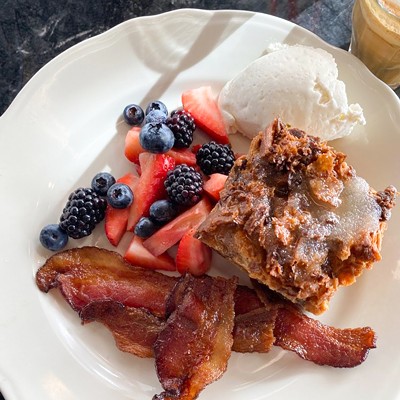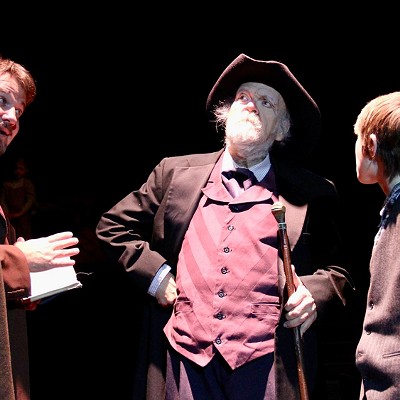Yet it’s worth the effort to revitalize a section of Oklahoma City that has been ignored much too long by city leaders, said Jaime di Paulo, business development coordinator for the Greater Oklahoma City Hispanic Chamber of Commerce.
The renaissance will likely occur because of a Business Improvement District (BID) that di Paulo and others are trying to finalize. If approved by Oklahoma City Council, the district would extend from Shields Boulevard to May Avenue.
The goal, di Paulo said, is to emu late the outward changes made by other BIDs in OKC, while retaining the Hispanic “flavor” of the area.
“We want to increase security, develop a marketing plan, clean up and improve the signage at each business,” he said. “We want to make it more attractive for the customers.”
Some of the focus will be to attract residents from other parts of the city to S.W. 29th, an area that has long suffered from image problems related to crime and poverty.
“That’s a misconception,” di Paulo said. “It’s not unsafe. It’s just ugly. We can be creative and do something nice.”
Attracting non-Hispanic customers to the proposed BID is critical, said Felix Perretti, owner of the furniture store Muebleria La Popular at 216 S.W. 29th.
“People
in north Oklahoma City don’t even want to cross the river. Why is
beyond me,” he said. “In 14 years, we’ve never had an incident that
required us to call police.”
Perretti
understands better than many the value of upgrading and beautifying
S.W. 29th, which many consider to be the Hispanic community’s unofficial
“main street.”
“We
want to create a [Hispanic] theme along S.W. 29th for businesses,
residents and visitors,” the Venezuelan-born Perretti said. “We want
things to look similar, but not the same. The city needs a Hispanic
district, just like the Asian District on Classen or the arts district
on Paseo.”

Here, there and everywhere
In
its current condition, S.W. 29th is a hodgepodge of retail stores,
bars, restaurants and abandoned buildings. Existing businesses have
little, if any, consistency in outside appearance. Public sidewalks and
streetscapes are nearly nonexistent. The landscape is dotted with used
car dealers who park some of their vehicles on old, crumbling sidewalks,
forcing pedestrians into the street.
But
BID funding, which would come from fees paid by area property owners,
could potentially pay for new sidewalks, modern light poles with
thematic banners, street upgrades and arched entryways at both ends of
the district.
First,
business leaders must obtain signatures from property owners who own at
least 51 percent of all frontage within district boundaries. The
Hispanic chamber is aiming for no less than 70 percent in an effort to
show strong community support. The petition will likely be circulated to
property owners next month.
After
collecting signatures, the BID application will be submitted to the
city’s planning department and later to city council. Hispanic chamber
officials say July 1, 2014, is the target date for the BID to begin
operations.
In the
meantime, chamber leaders are urging business owners to initiate cleanup
efforts of their buildings and surrounding property.
Direct competition

The
S.W. 29th BID wouldn’t be the first one approved in southwest OKC. In
March 2009, Oklahoma City Council granted the formation of the Capitol
Hill Business Improvement District. It includes commercial properties
along S.W. 25th, the south side of 24th Street and the north side of
26th, between Broadway and Walker avenues.
Those aren’t the only entities marketing to the OKC Hispanic population. There’s Plaza Mayor at the Crossroads,
a redevelopment project that is reportedly bringing restaurants, retail
stores, a nightclub and a rodeo arena to the former Crossroads Mall.
“They
all want to be separate and create their own thing,” said Kim
Cooper-Hart, an urban planner for the city. “Each one wants to have its
own beginning and end, and to create their own character. They don’t
want to blur the identity they’ve worked to create.”

The
three groups may have a common purpose of attracting more business to
the Hispanic community, but they remain in direct competition.
“They
may attend some of the same meetings and work on some of the same
projects, but in the end they’re saying, ‘This is my place,’ and, ‘This
is your place,’” Cooper- Hart said.
Di Paulo said S.W. 29th offers residents better shopping opportunities.
“You
can do just about anything you need to do. We have boots, tacos, used
cars and everything else,” he said. “You can go grocery shopping, send
money to grandma and go to an ice cream parlor. I don’t think you can do
that at Plaza Mayor or S.W. 25th.”
City help
Ramiro
Padillo, owner of La Oaxaqueña Restaurant, 741 S.W. 29th, is a champion
of the BID process, but is cautious about the city’s involvement.
“Nothing’s
been done on 29th, so they (area citizens) don’t think it will happen,”
he said. “At the beginning, people were skeptical, but now they’re
getting excited about it.”
Part
of the plan, Padillo said, is to create an inviting atmosphere along
the 29th corridor, which has 400 businesses from May to Shields.
“We
need to make it safe for people walking along the streets, shopping
from one business to another. Many Hispanics around Oklahoma City come
to S.W. 29th to shop because of a connection to their roots and
heritage,” he said.

About 30 percent of the property owners and 80 percent of the business owners in the six-mile corridor are Hispanic.
Ward 6 Councilwoman Meg Salyer, who represents part of the would-be BID, supports the project.
“When
property owners come together, the benefits are tremendous,” she said.
“This is an incremental process and doesn’t happen overnight. It just
takes time.”
Salyer,
who previously worked with the Main Street program, cited the Asian
District along Classen Boulevard as an example of a successful
private-public partnership that unified business owners and residents.
“They
(Hispanic chamber officials) want to create that same feeling,” she
said. “The city can provide best practices, seminars, training and seed
funding. But at the end of the day, the heavy lifting has to be done by
the community. It has to be a grassroots, pull-yourself-up-by-your-boots
attitude, and that’s the only formula I’ve seen that’s successful.”
That community
support appears to be there. On April 28, the Hispanic chamber organized
a special event, Dia de Ninos (Day of the Child). It drew an estimated
35,000 people who packed S.W. 29th from Walker to Western Avenue.
“We
wanted to show merchants the potential of what could happen,” di Paulo
said. “We had dancers, music, food and games all along the street.”
The
event’s success — plus the daily traffic count of 100,000 cars on 29th —
likely will encourage business owners to sign the petition and become
involved with the BID.
“The sky is the limit,” di Paulo said. “The potential for this area is unlimited.”
Hey! Read This:











